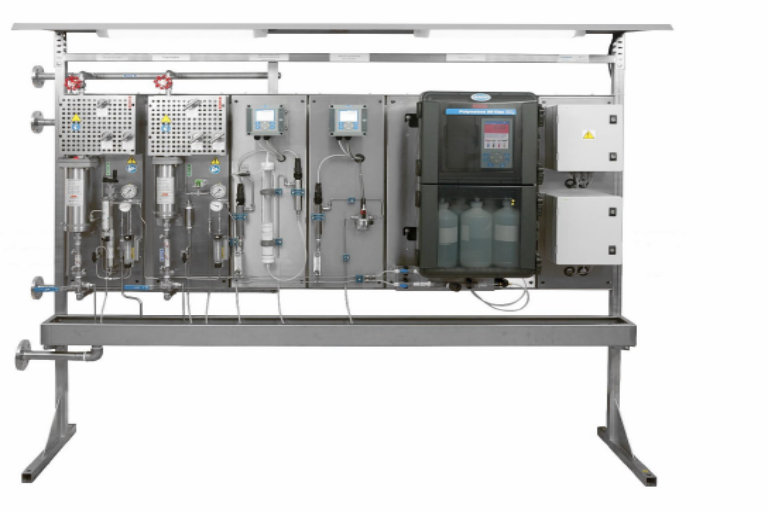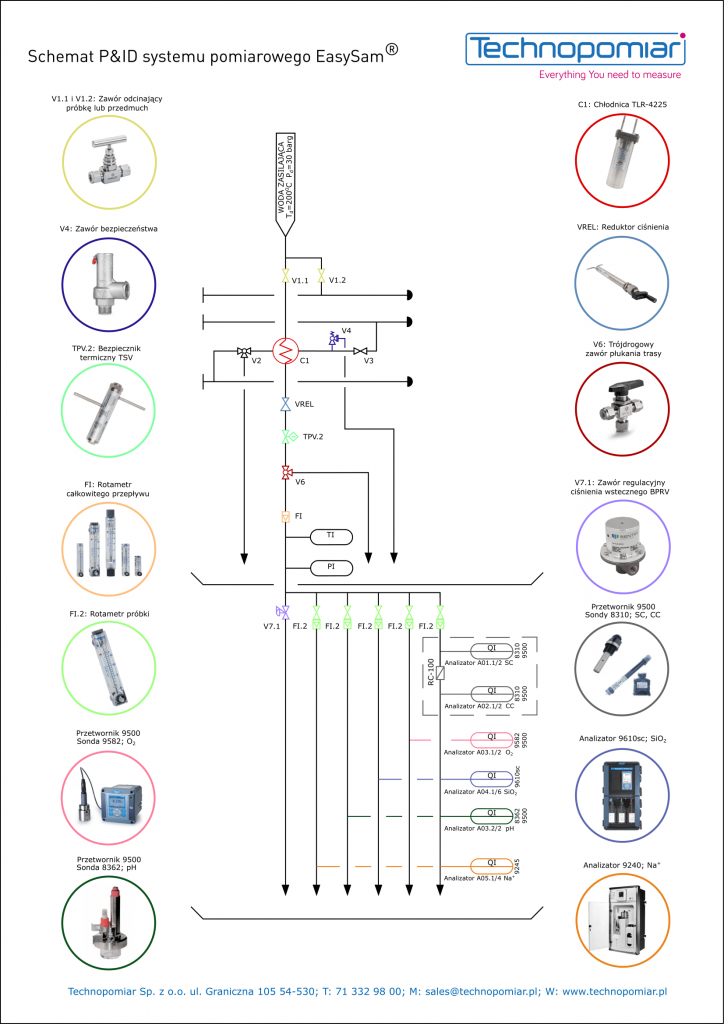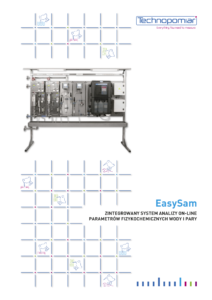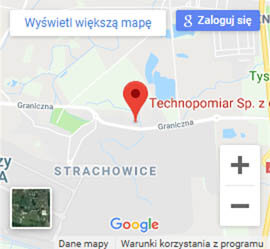ESS panels are a set of devices designed to collect and prepare the necessary amount of a representative sample. Coolers, thermal valves, rotameters and the necessary shut-off and three-way valves are mounted on a mounting plate (dimensions 300 x 915mm or 600 x 915mm) made of stainless steel. Lowering the temperature and reducing the pressure is necessary due to the individual requirements of the analyzers or probes. The EasySam product consists of two more components: ESA panels and ESR stand. More information below or in the catalog card.
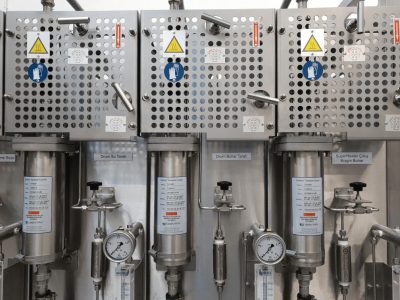
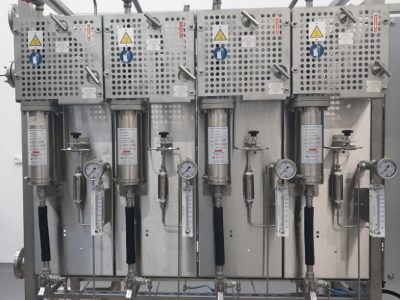
ESS components
Based on the EasySam Sampling ESS specification table, you can choose different types of devices depending on your installation requirements. We usually offer four types of coolers: TLR-4225, TLR-42B5 (Inconel), FLR-6225, FLR-62B5 (Inconel). We also offer two pressure regulators (H300 valve and VREL) as well as thermal valves (HST or TSV). Equipment should be adapted to the parameters and quantity of the sample. Description of selected components is below.
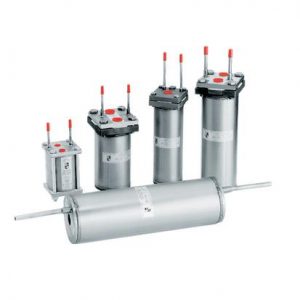
Coolers
The highest efficiency sample coolers available on the market for water and steam samples. Compact design, very low cooling water demand. Various configurations of sizes and materials (including Inconel for low quality cooling water) available. For samples up to 345 bar at 540oC (356 bar at 621oC for supercritical parameters on request).
Thermal shut off valve – TSV
Protects personnel, analyzers and sampling components against high temperature liquids. Suitable for pressures up to 303 bar. Totally mechanical design requires no electricity, air or hydraulics. Simple reset push-button, optional dry contact for remote indication. Standard trip temperature 49ºC (others possible). Constructed of 316 stainless steel (EN 1.4401).
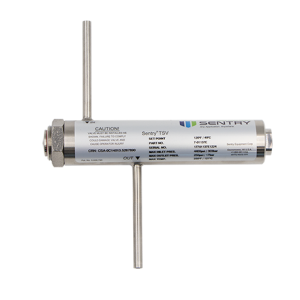
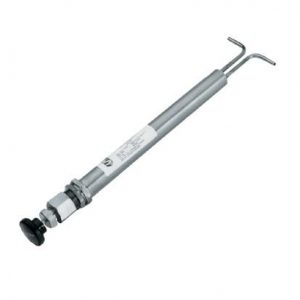
Pressure reducer – VREL®
Adjustable sample pressure reducer for sample pressures above 70 and up to 345 bar (or 538 bar for Inconel version on request). “Rod–in–tube” construction allows precise control of flow and pressure without VREL erosion or dissociation of any components. All wetted parts are fabricated from 316 stainless steel (EN 1.4401). Cleanable in place, “in – situ”, by retracting the rods without disconnecting from sampling panel.
Back Pressure Regulator (BPRV)
The Back Pressure Regulator / Relief Valve (BPRV) maintains constant pressure and constant flow to analyzers while protecting the analyzers as a safety valve. Precise pressure regulation and control when used in conjunction with a pressure reducer (VREL or pressure control valve).
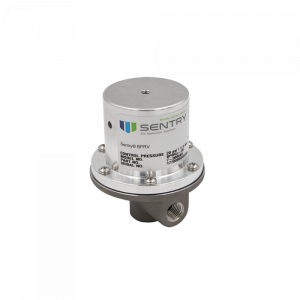
Konfiguracja panelu ESS
The EasySam® system can be specified in several steps listed in the tables below or in the product data sheet. Written numbers in the order from each step form the order code of the specific ESS panel. The number of order codes must be equal to the number of sample preparation panels (ESS) in a discussed measuring system.
Panel configuration
| ESS-1: for low sample parameters: < 70 bar / 380oC; (with V5, Ham-Let fittings). | 1 |
| ESS-2: for high sample parameters: < 345 bar / 540oC; (with VREL, Ham-Let fittings). | 2 |
| ESS-3: for low sample parameters: < 70 bar / 380oC; (with V5, Swagelok fittings). | 3 |
| ESS-4: for high sample parameters < 345 bar / 540oC; (with VREL, Swagelok fittings). | 4 |
Opcje zaworu płukania trasy
| None | 0 |
| V1.2: Single sample flushing shut-off valve (< 110 bar acc. to VGB)* | 1 |
| V1.2 + V1.3: Double sample flushing shut-off valves (> 110 bar acc. to VGB)* | 2 |
| V6: Tree-way valve for low pressure flushing (grab sample during start-up)** | 3 |
| V1.2 + V6: Single sample flushing shut-off valve & tree-way valve for low pressure flushing*, ** | 4 |
| V1.2 + V1.3 + V6: Double sample flushing shut-off valves & tree-way valve for low pressure flushing*, ** | 5 |
| * Hot drain shall be available ** Recommended for grab sampling during start-up (at low sample pressure) |
|
Opcje chłodnicy
| None (sample temperature < 45oC) | 0 |
| C1: TLR-4225 cooler, (316 stainless steel (EN 1.4401) tubing, 345 bar @ 540oC, for water and steam), Efficiency: < 1.8 l/min for water and < 1 l/min for steam. |
1 |
| C2: FLR-6225 cooler, instead of TLR-4225 (316 stainless steel (EN 1.4401) tubing, 345 bar @ 540oC, for water and steam) Efficiency: < 3.5 l/min for water and < 2 l/min for steam). Also for low pressure steam < 30 bar. |
|
| C3: TLR-42B5 cooler, instead of TLR-4225 (Inconel 625 tubing, 345 bar @ 593oC) for low quality cooling water | 3 |
| C4: chłodnica FLR-62B3, zamiast FLR-6225, (orurowanie z Inconelu 625, 234bar przy 593oC) dla niskiej jakości wody chłodzącej | 4 |
| C1 + V4: chłodnica TLR-4225 i zawór bezpieczeństwa (10 bar) dla wody chłodzącej | 5 |
| C2 + V4: chłodnica FLR-6225 i zawór bezpieczeństwa (10 bar) dla wody chłodzącej | 6 |
| C3 + V4: chłodnica TLR-42B5 i zawór bezpieczeństwa (10 bar) dla wody chłodzącej | 7 |
| C4 + V4: chłodnica FLR-62B3 i zawór bezpieczeństwa (10 bar) dla wody chłodzącej | 8 |
| UWAGA: Należy wziąć pod uwagę wymaganą ilość próbki: 200 ml/min dla przewodności, 100 ml/min dla pH, 100 ml/min dla O2, 100 ml/min dla Na+,150 ml/min dla SiO2, 150 ml/min dla PO4 i 350 ml/min dla poboru ręcznego.UWAGA 2: W komplecie z każdą chłodnicą są zawory V2 i V3. | |
Zabezpieczenie termiczne
| Brak | 0 |
| Brak + PI: brak termicznego zaworu odcinającego, występuje manometr | 1 |
| TPV.1: TSV Termiczny zawór odcinający (zatrzaskujący) – odcina przepływ próbki przy temperaturze powyżej 49oC. Ciśnienie do 303 bar | 2 |
| TPV.1 + PI: TSV Termiczny zawór odcinający (zatrzaskujący) – odcina przepływ próbki przy temperaturze powyżej 49oC. Ciśnienie do 303 bar. Występuje manometr | 3 |
| TPV.1A: TSV z alarmem (styk bezpotencjałowy: maks. 10 A przy 250 VAC) | 4 |
| TPV.1A + PI: TSV z alarmem (styk bezpotencjałowy: maks. 10 A przy 250 VAC). Występuje manometr | 5 |
| TPV.2: HST Samoresetujący się (po spadku temperatury) termiczny zawór odcinający zamiast TSV (wersja budżetowa).Ciśnienie do 207 bar | 6 |
| TPV.2 + PI: HST Samoresetujący się (po spadku temperatury) termiczny zawór odcinający zamiast TSV (wersja budżetowa). Ciśnienie do 207 bar. Występuje manometr | 7 |
| TPV.3: TSSV Wysokociśnieniowy zawór kulowy z silnikiem. Ciśnienie do 500 bar | 8 |
| TPV.3 + PI: TSSV Wysokociśnieniowy zawór kulowy z silnikiem. Ciśnienie do 500 bar. Występuje manometr | 9 |
Rotametr całkowitego przepływu (bez zaworu igłowego)
| Brak | 0 |
| FI.1: Rotametr całkowitego przepływu | 1 |
| FI.1A.NO: Rotametr całkowitego przepływu z alarmem niskiego przepływu (styk bezpotencjałowy NO: maks. 0,5 A, 230 VAC) | 2 |
| FI.1A.NC: Rotametr całkowitego przepływu z alarmem niskiego przepływu (styk bezpotencjałowy NC: maks. 0,5 A, 230 VAC) | 3 |
| MF + FI.1: 100 μm filtr + rotametr całkowitego przepływu | 4 |
| MF + FI.1A.NO: 100 μm filtr + rotametr całkowitego przepływu z alarmem niskiego przepływu NO | 5 |
| MF + FI.1A.NC: 100 μm filtr + rotametr całkowitego przepływu z alarmem niskiego przepływu NC | 6 |
| UWAGA: Filtry nie są zalecane, ponieważ zmieniają skład próbki – filtrują produkty korozji. | |
Zawór regulacyjny ciśnienia wstecznego
| Brak (tylko pobór ręczny) | 0 |
| Brak + FI.3: Brak zaworu regulacyjnego ciśnienia wstecznego, występuje rotametr z zaworem regulacyjnym (tylko pobór ręczny) | 1 |
| V7.1: BPRV – zawór regulacyjny ciśnienia wstecznego – zapewnia możliwość poboru reprezentatywnej próbki (zalecane) | 2 |
| V7.2: Zawór zwrotny zamiast BPRV – wersja budżetowa, bez możliwości regulacji | 3 |
| V7.1 + FI.3: BPRV + rotametr z zaworem regulacyjnym do poboru próbki | 4 |
| V7.2 + FI.3: Zawór zwrotny + rotametr z zaworem regulacyjnym do poboru próbki | 5 |
Analizator 1: pomiar przewodności SC, CC, lub DCC, lub pH wyliczane pHCal
| Brak | 0 |
| SC: Przewodność właściwa | A |
| CC: Przewodność kationitowa za kolumną kationitową | B |
| DCC: Przewodność kationitowa po odgazowaniu | C |
| SC + CC | D |
| SC + CC + pHCal: SC + CC + pH wyliczane z przewodności (przeznaczone tylko dla wód kondycjonowanych amoniakiem) | E |
| CC + DCC | F |
Analizator 2: pomiar pH
| Brak | 0 |
| pH | G |
| pHCal (przeznaczone tylko dla wód kondycjonowanych amoniakiem) | H |
Analizator 3: pomiar tlenu O2
| Brak | 0 |
| Elektrochemiczny O2 (ogniwo Clarka) | I |
| Luminescencyjny O2 | J |
Analizator 4: pomiar jonów sodu Na+
| Brak | 0 |
| Na+ 1-kanałowy | K |
| Na+ 2-kanałowy | L |
| Na+ 3-kanałowy | M |
| Na+ 4-kanałowy | N |
Analizator 5: pomiar krzemionki SiO2
| Brak | 0 |
| SiO2 1-kanałowy | O |
| SiO2 2-kanałowy | P |
| SiO2 4-kanałowy | Q |
| SiO2 6-kanałowy | R |
Analizator 6: pomiar fosforanów PO4
| Brak | 0 |
| PO4 1-kanałowy | S |
| PO4 2-kanałowy | T |
| PO4 4-kanałowy | U |
| PO4 6-kanałowy | V |
Panel
| Materiał panelu: stal nierdzewna 304 (EN 1.4301) bez zlewu | 1 |
| Materiał panelu: stal nierdzewna 304 (EN 1.4301) ze zlewem* | 2 |
| Materiał panelu: stal nierdzewna 316 (EN 1.4401) bez zlewu | 3 |
| Materiał panelu: stal nierdzewna 316 (EN 1.4401) ze zlewem* | 4 |
| * Opcja do wyboru tylko w przypadku, gdy panel nie będzie zamontowany na stojaku ESR | |
Wersja językowa dokumentacji
| Standardowo w języku polskim, wybierz 99; inne języki na życzenie | 9 |
Wersja językowa dokumentacji
| Standardowo w języku polskim, wybierz 99; inne języki na życzenie | 9 |
EasySam® system
ESS sample preparation panels and panels with measuring analyzers are mounted on a stainless steel rack. Cooling water, blowdown and drain collectors are attached to the main structure. It is also possible to specify the roof and lighting for the system.
